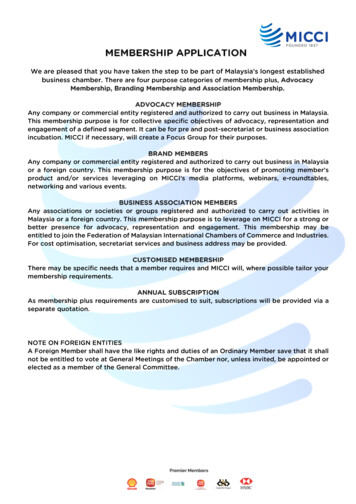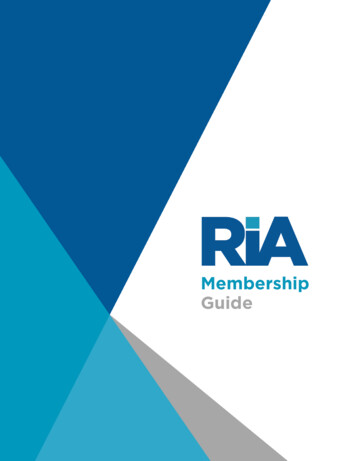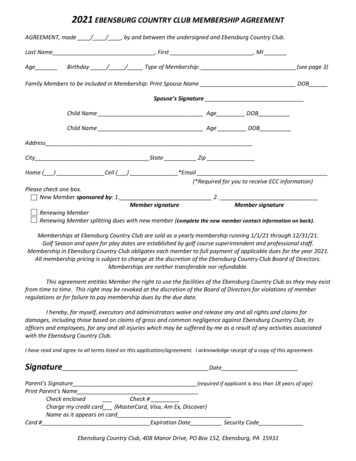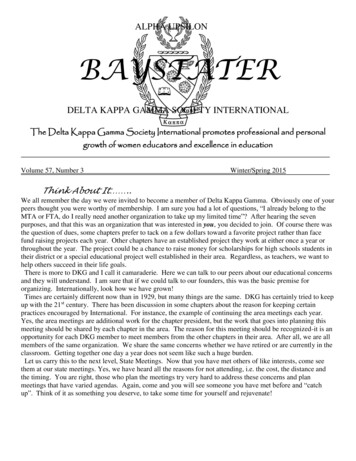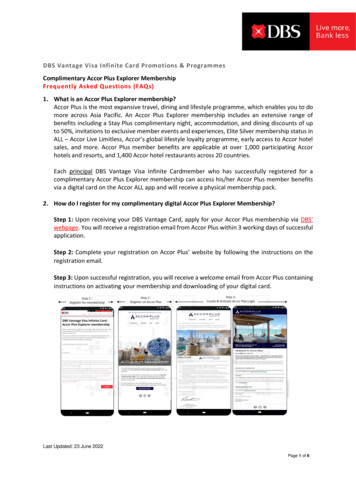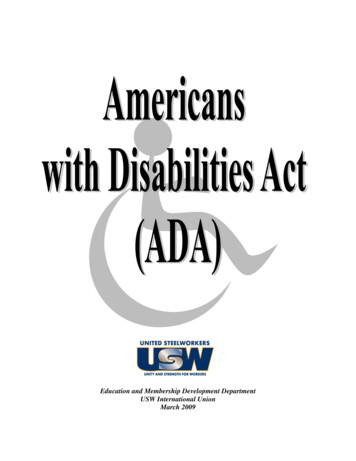
Transcription
Education and Membership Development DepartmentUSW International UnionMarch 2009
Table of ContentsOverviewThe ADA in the WorkplaceEnforcementWhat Does the ADA Required of Employers?ADA Issues in Unionized WorkplacesADA and the CourtsThe Union as a Public Accommodation or EmployerRemedies and Filing Requirements for ADA Claims3-44-677-1011-151617-1818APPENDIX AAPPENDIX BAPPENDIX C19-2021-2223-24APPENDIX DAPPENDIX EAPPENDIX FExamples of Physical ImpairmentsExamples of Mental ImpairmentsFlow Chart of ReasonableAccommodation ProcessJob Application and Pre-EmploymentQuestionsJAN—The Job Accommodation NetworkADA Act Quiz and Answers25-2627-4445-50This manual is intended to train Staff Representatives and Local Union leaders and provide substantiveinformation that will facilitate understanding of the ADA and its impact on workplaces and unions. Theinformation provided is general information and does not constitute legal advice or opinion, nor does itaddress specific individual problems. Individuals should seek professional legal advice before making anydecision affecting individual legal rights based on this specific topic.2
OverviewThe Americans with Disabilities Act (ADA), passed in 1990, prohibits an employer or unionfrom discriminating against qualified individuals with a disability because of the disability. In its definition of responsibilities, the ADA goes beyond other non-discrimination laws and requires the employerto consult with an eligible disabled employee to devise reasonable accommodations.As the result of several court decisions, which Congress believed too narrowly applied andinterpreted the law, the ADA Amendments Act of 2008 (ADAAA) was passed, which took effect January 1, 2009. The ADAAA sought to restore coverage and protections as originally intended, as well asexpanding protections to more individuals. It is clear now that determinations under the act must bemade in favor of broad coverage.This manual examines the various provisions of the ADA and ADAAA with an emphasis on itsapplication to employment in unionized establishments.The ADA has five titles:I.Employment (Title I).The ADA prohibits employers with 15 or more employees from discriminating againstqualified job applicants and workers who are disabled or who may become disabled.Title I covers all aspects of employment, including the application process and hiring,medical examinations, the work environment, on-the-job training, advancement andwages, benefits (including insurance), and employer sponsored social activities. ThisManual focuses on Title I.II.Public Services and Transportation (Title II).The ADA prohibits state and local governments from discriminating against people withdisabilities in their programs, services and activities.III.Public Accommodations (Title III).The ADA prohibits privately operated accommodations from denying goods, programsand services to people based on their disabilities. This title applies to unions. As employers, unions are obligated to make their offices accessible to employees with disabilities. In addition, as labor organizations, unions should consider reviewing the servicesand activities provided to members.IV.Telecommunications (Title IV).The Act requires telephone and other communications companies to provide telecommunications relay services to the hearing and speech impaired, 24 hours a day, 7 daysa week, at charges no higher than for regular services. Additionally, federally fundedtelevision stations must provide captioning for viewers with hearing impairments whenthey broadcast public service messages.3
V.Miscellaneous Provisions (Title V).Among other things, the Act also provides: that attorney fees be awarded to prevailingparties in an ADA suit; that use of illegal drugs not qualify as a covered disability; and thatstate and/or local laws providing greater protections for individuals with disabilities not besuperseded or limited by the ADA.The ADA in the WorkplaceA.Which Employers Are Covered?The ADA applies to employers having 15 or more employees. In addition to private sector employers (which includes employment agencies and joint labormanagement committees), state or local governments are subject to the ADA aswell. Coverage extends to the District of Columbia, U.S. Virgin Islands and PuertoRico.B.Which Employees Are Protected?The Act applies to all employees of covered employers. There is no minimum period of service an employee must attain before enjoying the protections of theADA. Generally, the Act protects: a qualified individual witha disability thatsubstantially limitsa major life activity.Let’s examine each of these in turn:1.A qualified individual is:a.b.c.d.An individual with a disability,who satisfies the requisite skill, experience, education and other jobrelated requirements of the position held or desired,who can, with or without reasonable accommodation,perform the essential functions (fundamental job duties) of such aposition.Factors to consider in determining the essential functions include:a.b.c.whether the reason the position exists is to perform that function,the number of employees available to perform the function,the degree of skill or expertise required to perform the function.4
Since the passage of the ADAAA, the law is clear that the determination of whether an impairment substantially limits a major life activity is made without regard to mitigating measures. The use ofmedication, medical supplies and hearing aids no longer serve to remove someone from “disability”status. The 2008 amendments exclude certain mitigating measures such as eyeglasses or contactlenses. An individual cannot claim protection under the ADA if ordinary eyeglasses or contact lenses takeaway the substantial limitation on sight. Negative side effects of mitigating measures may be consideredin determining whether an individual has a disability (i.e. - medication for Hepatitis C could involve seriousside effects).Regarded as Having a Disability.Individuals who are regarded by the employer as having a disability, whether or not they actuallydo, are also protected. Individuals who have a record of an impairment (i.e. a past workers compensationhistory) are protected. That is, if the employer acts as if the employee is disabled, the employee is protected. Others may consider the condition limiting because of some stereotypical thinking or attitude, orthe employee may have no impairment at all but the employer thinks they do and treats them as such. Inthese cases, you have to focus on the employer’s (or maybe even co-workers’) perceptions and what theemployer knows, not the condition.Those who appear to be impaired more than six months will also be “regarded as” under the 2008amendments. An individual will be “regarded as” if the employer thinks there is a physical or mental impairment that is expected to last more than 6 months. Impairments that have an actual or expected duration of 6 months or less (non-transitory) are not an impairment for purposes of being regarded as a disability.2.With a disability:a. A physical impairment – a physiological condition, cosmetic disfigurement or anatomical loss that affects one or more system:NeurologicalMusculoskeletalSpecial sense organsRespiratorySpeech inaryHematic and lymphaticSkinEndocrine(See attached Appendix A for examples.)b. A mental impairment – a mental or psychological disorder such as mental retardation,organic brain syndrome, emotional or mental illness and specific learning disabilities.(See attached Appendix B for examples.)5
3.That substantially limits a major life activity: Prevents an individual from performing a major life activity (see below for examplesof major life activities);Determination of whether the individual’s impairment substantially limits the individual,does not require extensive analysis;Must be current or present limitation - not potentially or hypothetically - in order todemonstrate disability.Factors to consider:a. the nature of severity or impairment;b. the duration or expected duration of the impairment (short term conditions are generally not covered);c. the permanent or long-term impact, or the expected permanent or long-term impactresulting from the impairment.d. an impairment that is episodic or in remission is a disability if it would substantially limita major life activity when said impairment is active.4.A major life activity: An everyday activity that an average person can perform with little or no difficulty, Includes: caring for oneself, performing manual tasks, seeing, hearing, eating, sleeping, walking, standing, lifting, bending, speaking, breathing, learning, reading, concentrating, thinking, communicating, and working. The ADAAA now includes “major bodily functions” as major life activities. This means,for example, functions of the immune system, normal cell growth, digestive, bowel,bladder, neurological, brain, respiratory, circulatory, endocrine and reproductive functions are now considered major life activities.6
What Does the ADA Require of Employers?The ADA makes it unlawful to discriminate in all employment practices such as: recruitment pay hiring firing promotion job assignment training leave lay-off benefits all other employment related activitiesThe ADA prohibits an employer from retaliating against an applicant or employee for assertinghis/her rights under the ADA. The Act also makes it unlawful to discriminate against an applicant or employee, whether disabled or not, because of the individual's family, business, social or other relationship orassociation with an individual with a disability.An individual with a disability (as an employee or potential employee) must be qualified to performthe essential functions of the job with or without reasonable accommodation, in order to be protected bythe ADA.The ADA requires the employer to make a reasonable accommodation if such permits a qualified applicant or employee with a disability to participate in the job application/hiring process, to performthe essential functions of a job, or to enjoy other benefits and privileges of employment in the same wayemployees without disabilities do. (See Appendix C for Flow Chart of Reasonable Accommodation Process.)7
A.Reasonable Accommodation.Reasonable Accommodation is any change or adjustment to a job or work environment that permits a qualified applicant or employee to perform essential functions of a job, or to enjoy benefits and privileges of employment equal to thoseenjoyed by those without disabilities. Examples of reasonable accommodationsinclude: providing or modifying equipment or devicesjob restructuring (changing marginal functions)part-time or modified work schedulesreassignment to a vacant position (bumping is not required)adjusting or modifying examinations, training materials or policiesproviding readers and interpretersmaking the workplace readily accessible to and usable by people with disabilitiesThe employee must ask for a reasonable accommodation unless their disability isknown or obvious, i.e. individual uses a wheelchair.B.Limitations to the Obligation to Reasonably Accommodate.An employer does not have to offer an accommodation if it would impose an undue hardship on the operation of the employer’s business. Undue hardship isdefined as an action requiring significant difficulty or expense, considering: C.The employer’s size, financial resources and nature and structure of its operation;Employer required to lower quality or production standards to make accommodation;Employer not required to provide personal use items such as glasses or hearing aids.More on the Reasonable Accommodation Process.1.Does the ADA Require Bumping?No, the ADA requires reassignment to a vacant position if no other reasonableaccommodation is available, but it does not require bumping. The Union’s positionis that the seniority system in the CBA applies and the disabled individual mustpossess sufficient seniority for the vacant job. Courts which have addressed thisissue have ruled that seniority systems cannot be overridden by the employer’sobligation to accommodate. The ADA does not grant disabled individuals superseniority.8
2.What About Preferential Treatment?An employer cannot prefer a qualified individual without a disability overanother qualified individual with a disability merely because the individualwith a disability may require a reasonable accommodation. At the sametime, however, an employer is not required to prefer an individual with adisability merely because of the disability.3.The Job Accommodation Network (JAN).JAN is a FREE federally funded service of the President’s Committee onEmployment of People with Disabilities, which assists parties in exploringreasonable accommodations in the workplace. JAN can be reach at 1800- ADA-WORK (1-800-232-9675). JAN is an excellent resource to usewhen the Union, the Employer, and possibly the Employee are deadlocked on what is a reasonable accommodation for a specific disability.(See JAN Materials, Appendix E.)D.Pre-Employment Considerations.1.Application Forms. Employers are prohibited from making pre-employment inquiriesabout the existence, nature or severity of an individual’s disability before a job is offered. Should not include questions about applicant’s health, medical treatment, prior legal drug use (prescription), worker’s compensationclaims, or number of sick days used in previous jobs. Inquiries as to particular disabilities are illegal unless inquiry is jobrelated and consistent with business necessity. Disability-related questions are permitted post-offer if all employees inthe same job category are asked the same questions.2.Interviews. Employers may not ask questions during personal interviews that arenot permitted on job application forms. Employers generally may not ask whether a reasonable accommodation is needed pre-offer, except in the case of a known or obvious disability. Employers may not ask questions that inquire about ability to performa major life activity, even if the questions do not inquire directly abouta disability. May ask if applicant can perform essential functions of the job with orwithout accommodation. Can ask if employee drinks alcohol, but not how much. Can ask if the applicant uses or abuses drugs because drug abuse isnot a covered disability.9
3.Pre-employment Tests. Medical examinations are not allowed pre-offer.Physical agility tests to determine physical qualifications that are jobrelated and a business necessity are allowed if given to all similarlysituated applicants.Drug testsHonesty tests, including polygraph testingAlcohol tests that require blood, urine, breath samples or the like maynot be administered at the pre-offer stage.(See Appendix F for examples of Job Application and Pre-Employment Questions)EnforcementEnforcement of the employment provisions of the ADA/ADAAA begins at the Equal EmploymentOpportunity Commission (EEOC). An individual must file a charge with the EEOC or state agency and obtain a right-tosue letter before filing a lawsuit.The time limit for filing a charge is 180 days unless the sister state agency operatesunder a work-share agreement, then, in some cases the time limit is 300 days.Call the EEOC’s toll-free number 1-800-669-EEOC for the nearest EEOC office.Website: www.eeoc.gov.The EEOC will investigate the charge and request a response from the employer. Thereafter, theEEOC may proceed with the case or may turn it back to the employee – whether it has determined therewas discrimination or not. When the EEOC turns the case back to the employee, it will issue a letter tellingthe employee that he has 90 days from the date of the letter to file his suit. If suit is not filed within thattime period, the matter is considered abandoned and suit cannot be brought later.10
ADA Issues in Unionized WorkplacesA.The Duty to Bargain Under the NLRA and the Duty to Comply With the ADA:GC Memorandum 92-9.Under Section 8(a)(5) of the National Labor Relations Act (NLRA) an employer has a duty to bargain in good faith with the union over terms and conditions of employment. An employer’s duty to bargainforbids the employer from changing working conditions of union-represented employees without first giving the union notice of the change and an opportunity to bargain. Also, during the term of a CBA neitherparty can alter the CBA without the other’s agreement.At the same time, the Employer also possesses a duty to comply with the ADA’s requirements. In1992, the NLRB’s General Counsel established, in a written memorandum, that the “reasonable accommodation” requirement under the ADA is an area in which the employer possesses discretion regardingcompliance and therefore must bargain with the Union during the reasonable accommodation process.GC Memorandum 92-9 (August 7, 1992) (“GC Memorandum”) Therefore, while an employer generallyhas no duty to bargain over changes in working conditions that are mandated by law (e.g. the minimumwage) where the law leaves the employer with some discretion regarding compliance, the employer violates §8(a)(5) of the NLRA by changing terms and conditions to bring itself into compliance.Specifically, the GC Memorandum indicates:1. No Unilateral Reasonable Accommodations Which Affect a Material or SubstantialChange in Working ConditionsUnder the ADA, the employer cannot discriminate and must provide a reasonable accommodation. Under the NLRA, a unionized employer cannot make a unilateral reasonable accommodation which affects a material, substantial or significant change inworking conditions.Examples of material accommodations include changes in the seniority system, jobfunctions or job classifications. Examples of non-material accommodation changesinclude putting a desk on blocks, installing a ramp, or providing additional lighting.2. The Employer Must Give Notice and Confer with the UnionAlthough the initial request for accommodation may come directly from the employeeto the employer, the employer must give notice to and confer with the union on reasonable accommodation issues which affect material conditions. An employer that bypasses the union and reaches an agreement with the disabled employee which is inconsistent with the CBA may be found to have directly dealt with the employee in violation of the NLRA.11
3. The Employer Cannot Bypass the Union and Negotiate Directly with the Affected Employee To Alter Terms and Conditions of the CBAUnder the NLRA, the Employer cannot bypass the Union and deal directly with employees to negotiate changes in terms and conditions of employment or any adjustments contrary to the CBA. If an employee with a disability requests an accommodation that would involve a change in the terms or conditions of employment, the employer must comply with the CBA unless a change is negotiated with the Union.4. The Terms of a CBA Help to Determine if an Accommodation is a Reasonable Accommodation or Would Create an Undue HardshipThe legislative history makes clear that the terms of a CBA agreement are relevant todetermine whether an accommodation is reasonable or would cause an undue hardship. “The employer simply cannot ignore the requirements of the Agreement withoutfirst attempting to find, through discussion with the Union, an agreed-upon solution thatis compatible with the Agreement and the law 1.”B. Non-Precedent Setting Agreements.The ADA should be looked at as a tool to benefit the workers in our bargaining units. There arerare situations where nothing else will be available to the disabled person but a position or shift that willrequire a variance from contractual provisions. If necessary, the Union can agree to a non-precedentialwaiver in those situations, if any non-disabled affected individuals are agreeable.The agreement should be a written understanding between the Employer and the Union, that, forexample, the employer can assign Employee X to the day shift even though Employee Y may have aclaim to the assignment. The agreement should explicitly state that it is non-precedential in nature.C. Information Requests - A Balancing Act.The ADA requires an employer to treat as confidential information concerning an employee’smedical condition. At the same time, however, the employer has a duty under the NLRA to provide itsemployees’ union with relevant information.Where the employer asserts a legitimate claim of confidentiality in response to a request for relevant information, the Board balances the Union’s need for the information against the assertion of confidentiality. Before balancing the interests, the Board will direct the parties to bargain to accommodate bothinterests.1 ClarkCounty Sheriff’s Dept., 102 LA 193, 197 (1994).12
An employer can only seek medical documentation when the disability and/or the accommodationis not obvious. If the disability is obvious, the employer may not seek further information. Note that anemployer cannot ask for documentation that is unrelated to determining the existence of a disability andthe necessity for an accommodation. This means that in most situations an employer cannot request aperson’s complete medical records because they are likely to contain information unrelated to the disability at issue and the need for accommodation. The ADA has specific protections for employee medicalinformation, and both employers and unions have an obligation to keep employee medical informationconfidential. To the extent that medical information is needed in the determination of a reasonable accommodation, the information could be provided by the employee. The EEOC has also stated that the ADAdoes allow the employer and the union to share with each other medical information necessary to the reasonable accommodation process.D. ADA Clauses in CBA’s.Unions normally resolve disputes with the employer through the grievance/arbitration procedureset forth in the collective bargaining agreement (CBA). ADA issues can be incorporated into the CBA byinserting of the word “disability” in non-discrimination clauses.2 This vests the arbitrator with authority todecide these issues, which are often complex—is the employee disabled, what reasonable accommodation is required, can the employer establish the accommodation would be an undue hardship, etc.3 TheADA can also be applied to successfully challenge termination of disabled employees.Beware of proposed language such as “The Employer [and Union] may take whatever actiondeemed appropriate [or necessary] to accommodate disabled individuals under the ADA.” When suchlanguage is included in the CBA, the union may find itself liable for refusing to accommodate a disabledmember who seeks a particular job assignment in violation of seniority provisions—or at least raises thequestion of whether violating seniority provisions is “necessary” to accommodate the disabled employee.Although this language was mentioned in the House and Senate debate on the ADA, the language is NOT MANDATED (as your Employer may try to insist) and your International is strongly opposedto any such addition to your CBA. This language would allow the employer to circumvent seniority provisions in a CBA. The union should avoid including such language in the contract.2A sample non-discrimination clause may read “The Company and the Union agree there shall be no discrimination in the application of the terms of this Agreement against any employee because of race, sex, religion, color,national origin, or disability.”3Whether a disabled employee’s accommodation could override seniority provisions in the CBA has been arbitrated in a number of cases. Most arbitrators have held that seniority could not be violated in order to accommodate a disabled employee. See “Americans with Disabilities Act—The Top Compliance Issues: A Union Perspective” by Jules L. Smith for the ABA Section of Labor and Employment Law Equal Employment Opportunity committee 1999 Midwinter Meeting, f. (Used by permission)13
E.Five Mistaken Assumptions Employers Make About the Americans withDisabilities Act (ADA).1. Employer may ignore the requirements of the collective bargaining agreement(CBA) if it is doing so to accommodate a disabled worker.2. Employer may ignore its duty to bargain if it is doing so to accommodate a disabled worker.3. The CBA’s terms are irrelevant to determine whether an accommodation wouldcreate undue hardship.4. Employer may bypass the union and directly negotiate with employee requesting accommodation.5. Union must incorporate into the CBA certain ADA anti-discrimination languagegiving employer the right to take whatever actions are necessary to complywith the ADA.F.What Role Can the Shop Steward Play in Assisting Implementation of the ADA?The union steward or grievance handler is the person in the union with whom each member mayhave direct contact, to whom members bring their problems and grievances, from whom members getinformation and who has access to employees during the work day. The union can disseminate vital information about the ADA through the shop steward or business agent to its members, such as the illegalityof discrimination against individuals with disabilities and how the reasonable accommodation processworks.14
G.What Should a Union (and the Company) do to comply with the ADA and NLRA?The employment discrimination provisions of the ADA apply to unions as employers and as bargaining agents. And under the NLRA, a union has a duty of fair representation; that is, in its representation activities, it must refrain from conduct that is arbitrary, discriminatory, or act in bad faith. USW locals typically meet and exceed these requirements. The best policy for the Union is to assist any disabledemployee in requesting a reasonable accommodation and working with the employer to determine thereasonable accommodations available to the employee. Accommodations should be evaluated in the following order:1.2.3.4.5.Try an accommodation that keeps the employee at work and fully performing their job.Keep the employee at work, but remove or change marginal (versus essential) functions.Allow the employee to telecommute.Grant leave.Offer reassignment.Employers can successfully argue that the accommodation will make it more difficult for other employees to do their jobs, would have to work harder, causing injuries. Negotiation is the key to finding thebest workplace accommodation. Here are few additional suggestions: Review employer policies and procedures for ADA/ADAAA compliance at everystage including hiring, medical testing, accommodation, leave and termination.Review the collective bargaining agreement to ensure that individuals are not subject to disability discrimination and consider including in the contract specific protections or safeguards for individuals with disabilities, procedures for the reasonable accommodation process, or development of a light duty program.Employers and unions might also present educational programs on the ADA, forinstance, open discussions on the effects of the ADA on the work environment byboth management and union personnel.Form a labor-management committee to discuss and consider ADA complianceissues and work with employees in the informal interactive process of determininga reasonable accommodation. The committee might also assist in the determination of the essential functions of the job, review what type of accommodations areneeded, and what type of accommodations are available or are possible within thecontext of the collective bargaining agreement.15
The ADA and the CourtsAs mentioned previously, courts have routinely ruled that the reasonable accommodation provisions of the ADA do not allow the employer to violate provisions of the CBA. The Supreme Court has decided several cases involving arbitration and other issues under the Americans with Disabilities Act. Below are some of these cases and how they can relate to your local membership.A. May employees sue over alleged discrimination under the ADA when their unioncontract requires grievances to be handled through arbitration?Yes. The Supreme Court has ruled that an arbitration clause does not require employees to use the arbitration procedure for an alleged violation of the ADA. In the case ofWright v. Universal Maritime Service Corporation4, the Supreme Court ruled that acontract provision that incorporates the ADA will not be construed as a waiver of anindividual’s right to bring a private lawsuit under the ADA unless the contract containsa “clear and unmistakable waiver” of such rights. In other words, employees are ableto file a claim under the ADA with the Equal Employment Opportunity Commission(EEOC) without taking part in the arbitration process. If the collective bargainingagreement contains a clear waiver of the employee’s rights to a judicial forum for federal claims of employment discrimination, then they must take part in the arbitrationprocess. This depends on your individual collective bargaining agreement. As a matter of policy, the Union prefers not to waive the rights of bargaining unit members topursue their rights under employment statutes in court (and outside of the contractualarbitration process).B. Can an agreement between an employer and an employee to arbitrate employment-related disputes ban the EEOC from pursuing relief under the ADA?No. An arbitration agreement between an employee and employer does not bar theEEOC from pursuing relief in an ADA enforcement action. In the Universal Maritimecase, where an employee had given up the right to go to court, the Supreme Courtreasoned that Congress had nonetheless authorized the EEOC to obtain court reliefarising out of the same facts. In essence, the Court found that an arbitration agreement between private parties doesn’t diminish the EEOC’s statutory function or theremedies oth
c. the permanent or long-term impact, or the expected permanent or long-term impact resulting from the impairment. d. an impairment that is episodic or in remission is a disability if it would substantially limit a major life activity when said impairment is active. 4. A major life activity:
